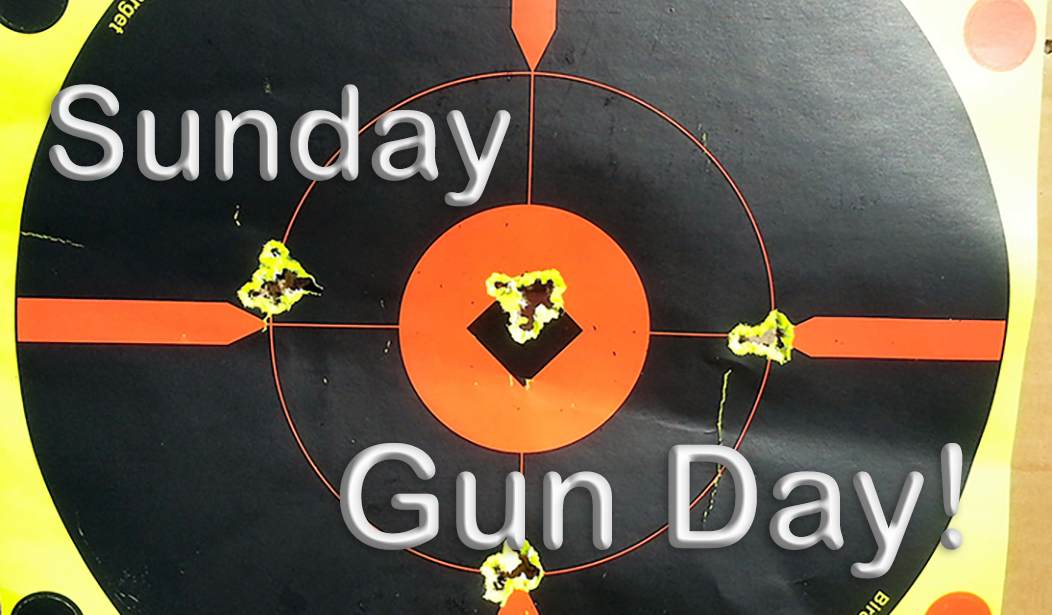History Repeats Itself - Meanwhile, in Switzerland
Previously on RedState: Sunday Gun Day XXIX - The History of Bolt Guns, Part I
When most folks – well, most non-gun folks – think of Switzerland, they think of discreet banking, skiing, and chocolates. But Switzerland is a country with a martial tradition as well as a tradition of producing fine firearms; for example, the Sig P-210 may well be the finest semi-auto pistol ever made.
In 1866, well before the P-210 came into being, the Swiss Federal Council was looking around their neighbors and seeing the various brass-cartridge, single-shot breechloaders that were coming into vogue in military circles. They looked at the Dreyse and Gras bolt guns fielded by the Germanic states and France. Being Swiss, they figured they could do the others one better; being Swiss, they were right. But the original idea came from an American innovation. Being Swiss, they would never admit that.
At the time the Swiss Army was using the Eidgenössischer Stutzer 1851 (Federal Carbine 1851), which was an Amsler-Milbank metallic cartridge conversion from the previously used muzzle-loading rifle/musket. The Federal Carbine 1851 was a trapdoor action roughly similar to the U.S. 1874 Springfield rifle but firing a 10.4mm (.41 caliber, more or less) cartridge. This single-shot arm put the Swiss on an even footing with their neighbors, rifle-wise, but that situation wasn’t destined to last.
In 1867, the Swiss military adopted the Repetiergewehr Vetterli, Modell 1867 (Model 1867 Vetterli Repeating Rifle). The 1867 and the various iterations of the same rifle that followed, the 1868, 1869, 69/71, 1871, 1871 carbine, 1878, and 1881, all had several things in common. First among them was a different locking mechanism; unlike the guide rib-locking lug combo seen on the Dreyse, Gras, and early Mauser rifles, the Vetterli guns had two locking lugs at the rear of the bolt. While the 1867 version had an external hammer, the 1868 and later models used a coil spring-driven striker inside the bolt. But the major innovation was an 11-round tubular magazine under the barrel that was loaded through a loading gate on the right-hand side of the action.
Sound familiar?
 Now, I’m not saying the folks at Vetterli looked across the Atlantic and noticed the feeding setup of the highly successful 1866 Winchester repeater, but if they had, it would certainly explain their adoption of a very similar mechanism for their repeating rifle.
Now, I’m not saying the folks at Vetterli looked across the Atlantic and noticed the feeding setup of the highly successful 1866 Winchester repeater, but if they had, it would certainly explain their adoption of a very similar mechanism for their repeating rifle.
The Vetterli was very successful but had a few drawbacks. It fired the .41 Swiss rimfire cartridge, which only developed slightly more performance than the .44 Henry round used in the ’66 Winchester. Its tubular magazine worked well but limited the soldier to topping up the magazine one round at a time. For a hunting rifle, this isn’t anything more than an inconvenience, but in a military weapon, a fast reload could literally be the difference between life and death.
But in 1870, an Italian artillery Captain named G. Vitali looked at the Swiss Vetterli and had an idea: what about a box magazine under the receiver rather than a Winchester-style tubular magazine? The result of this was the Modello 1870/87 Vetterli-Vitali, an adaptation of the Swiss design with a fixed box magazine, which was charged with a four-round stripper clip. While this innovation reduced the rifle's capacity, it greatly reduced reloading time. This was the first mass-produced bolt-action repeater with a box magazine.
Mauser Steps Up
Over in Oberndorf, Paul Mauser wasn’t missing the trend.
The Vetterli rifle had given a European power a bolt-action repeater for the first time. Mauser was at that time cranking out the 1871 Mauser single-shot, but the engineer in Paul Mauser saw room for improvement; it took an alliance with an Austrian to make that happen.
Alfred Ritter von Kropatschek was a general in the Austrian Army as well as a weapons designer of note. One of his own designs, the Kropatschek rifle, a bolt-action repeater with a tubular magazine, was adopted by the Kingdom of Portugal in 1886; Kropatschek also dabbled in revolvers and had several other rifle designs used by France and Portugal manufactured at the Steyr/Mannlicher works in what was then the Austrian Empire.
One of Krotpatschek’s contemporaries in his affiliation with the Steyr company would soon have a significant impact on the bolt gun world; that contemporary’s name was Ferdinand Mannlicher. We’ll talk more about him in a later segment.
Back to Mauser. In 1884, Mauser-Werke updated with 1871 Gewehr 71 with an 8-round tubular magazine designed by Alfred von Kropatschek. This new rifle became known as the Gewehr 71/84 and was the first production Mauser repeater.
Peter Mauser, the marketing side of the Mauser family, had died in 1882, but Mauser’s marketing efforts before and after the alliance with von Kropatschek had led to company to look beyond the military market. Germany has a long-standing outdoor tradition as well, with German sportsmen going afield after red deer, roebuck, and wild boar; the powerful 11mm Mauser black-powder round was well suited for the larger game of the German states.
Speaking for myself, I’ve never fired one of the black-powder Mausers, but I once had the chance to examine a very interesting sporting rifle, this one a 71/84 repeater with a carbine-length barrel, butter-knife bolt handle, nice European walnut stock with a half-length forearm that left much of the 6-shot magazine tube exposed, and some kind of aftermarket open sights that I couldn’t recognize and which were presumably contemporary with the rifle’s origins. I would have loved to have fired it, but the venue (a Denver-area gun show) and the difficulty in obtaining 11mm Mauser ammo in this modern era precluded it. But I would have enjoyed taking this carbine into the game fields. The rifle was light and handy and, in a tribute to Mauser engineering, even after well over a hundred years, the action was still tight and crisp.
The 1871 and 71/84 were the first big commercial successes for Mauser. Besides civilian sales, the 1871 and its descendants saw service in the German armies as well as those of the Ottoman Empire, Serbia, and Transvaal. The 1871 was used by the Irish Volunteers in the Easter Rising; the Japanese samurai used the 1871 Mausers in the Satsuma Rebellion. Other nations that used this rifle included Honduras, Venezuela, Ecuador, Uruguay, and on the other side of the planet, China and Korea. All in all, almost two million of these guns were made.
With the 71 and 71/84, Mauser had made their mark in the military world as a bolt gun designer. That mark would only broaden and improve as the world turned into the late nineteenth and early twentieth centuries.
Speaking of Japan
It's important to remember that Japan was a country with a proud martial tradition and was, in fact, a rather militarized culture up until about 1945, when the thrashing they received at the hands of folks like Douglas MacArthur, Chester Nimitz, Curtis LeMay, and my Uncle Carl forced them to re-think that stance.
But in 1880, Japan was just pulling its military structure and equipment into what was then the modern era. They had been importing various weapons for their army, including French Chassepot and Gras rifles, British Snider-Enfields, and even some American Spencer repeaters. The experiences the Japanese Army had in the Boshin War brought home the need for a domestically produced, standardized infantry weapon.
At this time, a young fellow named Murata Tsuneyoshi was a Major of infantry in the Japanese Imperial Army, and in addition to his military duties, he fancied himself a designer of infantry rifles. He had examined several French Gras rifles and adapted their design to local production, producing a single-shot bolt gun that became the Murata Model 13, named so as it was adopted in the 13th year of the reign of Emperor Meiji, the standard by which Japan reckoned calendar years.
Like their European counterparts, the Japanese were not long content with a single-shot rifle. The Murata rifle went through several innovations, including experimentation with box and tubular magazines; these experiments culminated with the Murata Type 22, which had a tubular magazine under the barrel. The Type 22 entered service in 1889. Murata rifles saw service in the first Sino-Japanese War, the Donghat Peasant Rebellion, the Boxer Rebellion, the Russo-Japanese War, the Siberian Intervention, and the Great War.
Meanwhile, in Russia
The Russian Empire’s first breechloader was known as the Berdan 1, another trapdoor breechloader that was manufactured in the United States by our old friends at Colt. Adopted in 1868, the Berdan 1 fired a .42 caliber Berdan-primed (obviously) black powder cartridge. But in 1870, Russia adopted the Berdan 2, a single-shot bolt gun. As seems often to be the case with Russian designs, the Berdan 2 was something of an odd duck. Like the Dreyse, Gras, and 1871 Mauser, it used the guide rib as a locking lug; unlike the other guns, when the action was closed, the bolt handle projected upwards about 30 degrees above the horizontal. The reasons behind this are unknown.
But in the meantime, the French were once again about to set a new standard for martial bolt guns.
The French Break New Ground
In 1884, the same year the brothers Mauser were converting their successful 1871 model into a repeater, a Frenchman named Paul Vielle was experimenting with cartridge propellants based on nitrocellulose. In case you weren’t aware, this was the basis for the first smokeless gun powders, which was what Vielle came up with, inventing Poudre B, which packed about triple the punch of black powder. Two years before that, another Frenchman, this one an Army Captain by the name of Eduard Rubin, had come up with a rather interesting new bullet that had a protective copper jacket completely wrapped around the lead core, allowing the bullet to be fired at high velocities without deforming.
In 1886 the French Minister of War, General Georges Ernest Boulanger, determined that these two French inventions could be the basis for a fine new infantry rifle. He wasn’t wrong. The result of his intentions was given form in the 1886 Lebel rifle, a bolt-action repeater with an 8-round tubular magazine under the barrel. The Lebel used the 8mm Lebel cartridge, which fired a fully-jacketed spitzer bullet at about 2200 feet per second, a pretty impressive performance for the time.
Incidentally, it’s a common worry among those who shoot guns with tubular magazines that a pointed bullet in the magazine may set off the round ahead of it under recoil, which despite a lot of ink spilled on the topic, most gun cranks can’t produce an example of this happening. The Lebel used just such a pointed, full-jacketed bullet, and got around it with the expedient of a groove around the primer of the 8mm Lebel cartridge that caught and held the point of the bullet to the rear in the magazine, preventing any possible chain fire. This was a solution that, while awkward, would appear to be successful since there are no known examples of a chain fire in the Lebel rifle.
The Lebel proved popular among the soldiers of the French Army despite the difficulty of loading its tubular magazine one round at a time. The rifle and its 8mm smokeless powder cartridge were superior to the black-powder 71/84 Mauser, the Swiss and Italian Vetterli, and the Russian Berdan rifles used elsewhere at the time. The Lebel rifle was used to good effect in several pre-Great War conflicts such as the Boxer Rebellion, the first Italo-Ethiopian War, and the Monegasque Revolution. When the Great War broke out it was still the standard French infantry rifle and turned in a good performance in that war to end all wars. Lebels found their way into military service from Algeria to Vietnam, and civilian versions without the bayonet lug and stacking rod were sold all over to sportsmen as well. This was, after all, in some ways a more civilized time, when "weapons of war" were often the basis for sporting rifles, instead of the object of bloviating by politicians.
See Related: WATCH: Trump Pledges to Protect Gun Rights in Fiery Speech: 'No One Will Lay a Finger on Your Firearms'
Major Credit Card Companies to Adopt Code to Track Firearms, Ammo Purchases, Per CA Law
But while the Lebel denoted the entry of bolt guns into the smokeless powder era, it was soon eclipsed by developments in Germany, Russia, and elsewhere.
And Then This Happened
We’ve already examined how the introduction of smokeless powders and the resulting increase in performance and chamber pressures changed the lever gun world. The changes were even more dramatic in the bolt gun world, as the simple design of the bolt-action repeater allowed for some very tough actions capable of withstanding serious chamber pressures.
Both military and civilian arms would take advantage of this innovation. Rifles were now built for the new propellants whose names would live on in gun-making history; besides the Mauser folks, such names as Mannlicher, Lee-Enfield, Mosin-Nagant, Krag, and Springfield were now about to come to the fore.
Also, in 1914, the Great War would begin. This, the world’s largest war of attrition in history (so far), would be more than any other, the war of the bolt gun. Big things were about to happen – but that’s a story for the next installment.














